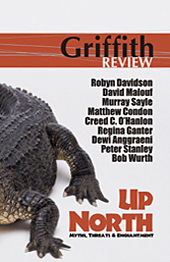Featured in

- Published 20050906
- ISBN: 9780733316715
- Extent: 232 pp
- Paperback (234 x 153mm)

Already a subscriber? Sign in here
If you are an educator or student wishing to access content for study purposes please contact us at griffithreview@griffith.edu.au
Share article
More from author

Diminishing city
EssayEXACTLY FIFTY YEARS ago, in the spring of 1966, my family left the Pennington Migrant Centre in Adelaide to drive up Highway 1 to...
More from this edition

From a moving car
MemoirIT'S 1979 AND I'm 15, fucked up and restless. My mother and I are living alone after years of domestic violence with her deranged...

Beyond the Brisbane Line
IntroductionIT MAY BE the product of living in the second most southerly continent, but every generation of Australians has had iconic images of threats...

The delegation
ReportageEverything must changeIn order that nothing changes– Giuseppe di LampedusaLONG BEFORE EIGHT-PACK units, a Mexican restaurant, two newsagents and a music school had bloomed...